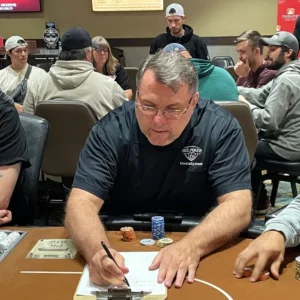Tagged: EV
-
Expected Value Applet
Posted by arw on August 18, 2021 at 6:47 pmI’ve created an applet to model call EV.
https://www.geogebra.org/classic/hgunzctu
The function takes in two parameters (%win, %call) that are found on the slider bars. As in, how often the hero wins and how often the opponent calls the bet.
The blue dot is your “bet size”. As you move it, it will show your call EV under those conditions. As you change the settings, you will see the line graph undergo changes.
Things to think about:
— When % call increases, the graph ________
— When % win increases, the graph ________
— When % win > 50, the graph _______
— When % call > 50, the graph _______
— Where is the x-intercept at different %wins?
The intercept for 40% win is confusing. It recommends betting 200 regardless of how often you’re called. Seems like it needs correction.
Any advice?
arw replied 2 years, 8 months ago 2 Members · 4 Replies -
4 Replies
-
This is nice graphical representation of Call EV.
Your equation for Call EV is correct for single river bets and calls.
The expected wins are the Win % times the original pot (before the bet and call) and the opponents call of our bet. The losses are loss % times our bet. The loss % can be calculated as 1 – Win %. The net profit is the Since the opponent doesn’t always call and sometimes folds, we need to multiply the frequency of calling to get the Call EV.
Call EV = Call% x [ Win% x (pot + bet) – (1-Win%) x bet]
In your example, we win 40% of time when called and we bet 2x pot
Win% = 40% = 0.40
Bet = 2 x pot
Substituting in the equaton:
Call EV = Call% x [0.40 x (pot + 2 x pot) – (1-0.40)x 2 x pot]
= Call % x [0.40 x 3 x pot – 0.60 x 2 x pot]
= Call % x [1.2 x pot – 1.2 x pot] = Call % x 0 = 0
So no matter the calling percentage of our opponent, the call EV is zero.
-
But Call Ev is not the whole picture. When we bet and our opponent folds, we win the pot.
Total EV = Fold EV + Call EV
= (1 -Call% x pot) + Call% x [ Win% x (pot + bet) – (1-Win%) x bet]
In the previous example, we had Win% of 40% when called and we bet 2x pot. Call EV was 0 no matter the Call %.
Let’s say Call % is 75%. So our opponent folds 25% of the time.
Fold EV = (25% x pot)= 0.25 pot
Call EV = 0
Total EV = 0.25 pot.
If our range includes a balance of value hands and bluffs, it’s possible to construct a betting range and choose a bet size that profits regardless of our opponents calling frequency.
-
This is a revision.
https://www.geogebra.org/classic/rnvq9ctf
It shows the Fold EV, Call EV, Total EV and the numbers being calculated.
-
-
Fold EV = (%F)(Pot) = (1-%C)(Pot)
Call EV = (%C)[(%W)(Pot + Bet) – (1-%W)(Bet)]
Total EV = Fold EV + Call EV
Scenario 1
— When you have no chance to win and you estimate the opponent should fold 50% of the time when you bet.
According to the graph,
— The x-intercept for this graph is 100 when W=0% and C=50%. This represents the maximum amount that I should bet to make it a +EV spot. If I bet larger, I’m risking too much. When I bet smaller, my call EV is being minimized, thus I’m risking less to possibly get my opponent to fold.
Fold EV = (fold50% * 100) = 50
Call EV = (call50% * (-B)) = -B/2
Total EV = 50 – B/2
— The slope of the Total EV plot is (-1/2) and the y-intercept is 50. The y-intercept represents the “best we can do” in-terms of total EV when we win less than 50% of the time. In this case, the y-intercept is equal to our fold EV since we have negative call EV with 0% chance to win.
Log in to reply.

 Keith Brandt 5-hour Coaching Package
Keith Brandt 5-hour Coaching Package 